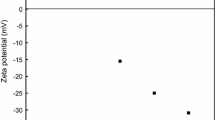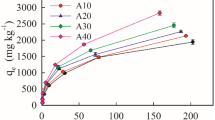Abstract
Batch experiments have been carried out to study the adsorption of heavy metals in soils, and the migration and transformation of hexavalent chromium (Cr(VI)) in the soil of a vegetable base were studied by dynamic adsorption and desorption soil column experiments. The aim of this study was to investigate the effect of initial concentration and pH value on the adsorption process of Cr(VI). Breakthrough curve were used to evaluate the capacity of Cr(VI) adsorption in soil columns. The results show that the higher the initial concentration, the worse the adsorption capacity of Cr(VI). The adsorption of Cr(VI) was strongly sensitive to pH value. The capacity of Cr(VI) adsorption is maximized at very low pH value. This may be due to changes in pH that cause a series of complex reactions in Cr(VI). In a strongly acidic environment, the reaction of Cr(VI) with hydrogen ions is accompanied by the formation of Cr3+, which reacts with the soil free iron-aluminum oxide to produce hydroxide in the soil. The results of the desorption experiments indicate that Cr(VI) is more likely to leach from this soil, but if the eluent is a strong acid solution, the leaching process will be slow and persistent. During the experiment, the pH value of the effluent was in the range of 7–8.5, which tends to the original pH value of the soil. It is indicating that the soil has a strong buffer on the acid liquid. The program CXTFIT was used to fit the breakthrough curve to estimate parameters. The results of the calculation of the dispersion coefficient (D) can be obtained by this program. The two-site model fit the breakthrough curve data of Cr(VI) well, and the parameters calculated by the CXTFIT can be used to explain the behavior of Cr(VI) migration and transformation in soil columns. When pH = 2, the retardation factor (R) reach at 79.71 while the value of the R is generally around 10 in other experiments. The partitioning coefficient β shows that more than half of the adsorption sites are instantaneous in this adsorption process and non-equilibrium affects the Cr(VI) transport process in this soil.
















Similar content being viewed by others
References
Aksu Z, Gönen F (2004) Biosorption of phenol by immobilized activated sludge in a continuous packed bed: prediction of breakthrough curves. Process Biochem 39(5):599–613
Babu BV, Gupta S (2008) Adsorption of Cr(VI) using activated neem leaves: kinetic studies. Adsorption 14(1):85–92
Bai L, Wang Y (2009) A review of studies on the transformation of chromium in soil and groundwater. Geol Res 18(2):144–148
Baral SS, Das N, Ramulu TS, Sahoo SK, Das SN, Chaudhury GR (2009) Removal of Cr(VI) by thermally activated weed Salvinia cucullata in a fixed-bed column. J Hazard Mater 161(2–3):1427–1435
Barrera-Díaz CE, Lugo-Lugo V, Bilyeu B (2012) A review of chemical, electrochemical and biological methods for aqueous Cr(VI) reduction. J Hazard Mater 223–224:1–12
Bolan NS, Adriano DC, Natesan R, Koo BJ (2003) Effects of organic amendments on the reduction and phytoavailability of chromate in mineral soil. J Environ Qual 32(1):120–128
Brusseau ML, Hu Q, Srivastava R (1997) Using flow interruption to identify factors causing nonideal contaminant transport. J Contam Hydrol 24(3):205–219
Chen Y, He Z, Wu J (1994) Morphology and transformation of chromium in soil. Environ Sci 3:53–56+93
Chen S, Yue Q, Gao B, Li Q, Xu X, Fu K (2012) Adsorption of hexavalent chromium from aqueous solution by modified corn stalk: a fixed-bed column study. Bioresour Technol 113:114–120
Dhal B, Thatoi HN, Das NN, Pandey BD (2013) Chemical and microbial remediation of hexavalent chromium from contaminated soil and mining/metallurgical solid waste: a review. J Hazard Mater 250-251(2):272–291
Fendorf S, Wielinga BW, Hansel CM (2001) Chromium transformations in natural environments: the role of biological and abiological processes in chromium(VI) reduction. Int Geol Rev 42(8):691–701
Flora SD (2000) Threshold mechanisms and site specificity in chromium(VI) carcinogenesis. Carcinogenesis 21(4):533–541
Florido A, Valderrama C, Arévalo JA, Casas I, Martínez M, Miralles N (2010) Application of two sites non-equilibrium sorption model for the removal of Cu(II) onto grape stalk wastes in a fixed-bed column. Chem Eng J 156(2):298–304
Gu X, Xie J, Wang X, Evans LJ (2016) A simple model to predict chromate partitioning in selected soils from China. J Hazard Mater 322:421–429
Gupta S, Babu BV (2009a) Modeling, simulation, and experimental validation for continuous Cr(VI) removal from aqueous solutions using sawdust as an adsorbent. Bioresour Technol 100(23):5633–5640
Gupta S, Babu BV (2009b) Removal of toxic metal Cr(VI) from aqueous solutions using sawdust as adsorbent: equilibrium, kinetics and regeneration studies. Chem Eng J 150(2–3):352–365
Halim CE, Short SA, Scott JA, Amal R, Low G (2005) Modelling the leaching of Pb, Cd, As, and Cr from cementitious waste using PHREEQC. J Hazard Mater 125(1–3):45–61
Hasan SH, Srivastava P, Ranjan D, Talat M (2009) Biosorption of Cr(VI) from aqueous solution using A. hydrophila in up-flow column: optimization of process variables. Appl Microbiol Biotechnol 83(3):567–577
Hellerich LA, Nikolaidis NP (2005) Studies of hexavalent chromium attenuation in redox variable soils obtained from a sandy to sub-wetland groundwater environment. Water Res 39(13):2851–2868
Kamra SK, Lennartz B, Genuchten MTV, Widmoser P (2001) Evaluating non-equilibrium solute transport in small soil columns. J Contam Hydrol 48(3–4):189–212
Kanwal F, Rehman R, Mahmud T, Anwar J, Ilyas R (2012) Isothermal and thermodynamical modeling of chromium(III) adsorption by composites of polyyaniline with rice husk and saw dust. J Chil Chem Soc 57(1):1058–1063
Khezami L, Capart R (2005) Removal of chromium(VI) from aqueous solution by activated carbons: kinetic and equilibrium studies. J Hazard Mater 123(1–3):223–231
Kumar PA, Ray M, Chakraborty S (2007) Hexavalent chromium removal from wastewater using aniline formaldehyde condensate coated silica gel. J Hazard Mater 143(1–2):24–32
Malkoc E, Nuhoglu Y, Dundar M (2006) Adsorption of chromium(VI) on pomace—an olive oil industry waste: batch and column studies. J Hazard Mater 138(1):142–151
Martí E, Sierra J, Cáliz J, Montserrat G, Vila X, Garau MA, Cruañas R (2013) Ecotoxicity of Cr, Cd, and Pb on two Mediterranean soils. Arch Environ Contam Toxicol 64(3):377–387
Padmavathy KS, Madhu G, Haseena PV (2016) A study on effects of pH, adsorbent dosage, time, initial concentration and adsorption isotherm study for the removal of hexavalent chromium (Cr(VI)) from wastewater by magnetite nanoparticles. Proc Technol 24:585–594
Pang L, Close ME (1999) Non-equilibrium transport of Cd in alluvial gravels. J Contam Hydrol 36(1/2):185–206
Setshedi KZ, Bhaumik M, Onyango MS, Maity A (2014) Breakthrough studies for Cr(VI) sorption from aqueous solution using exfoliated polypyrrole-organically modified montmorillonite clay nanocomposite. J Ind Eng Chem 20(4):2208–2216
Singha S, Sarkar U (2015) Analysis of the dynamics of a packed column using semi-empirical models: case studies with the removal of hexavalent chromium from effluent wastewater. Korean J Chem Eng 32(1):20–29
Stagnitti F, Li L, Barry A, Allinson G (2001) Modelling solute transport in structured soils: performance evaluation of the ADR and TRM models. Math Comput Model 34(3–4):433–440
Toma O, Tofan L, Paduraru C, Teodosiu C (2015) Fixed bed column study on the removal of chromium (III) ions from aqueous solutions by using hemp fibers with improved sorption performance. Cellulose Chem Technol 49(2):219–229
Valderrama C, Arévalo JA, Casas I, Martínez M, Miralles N, Florido A (2010) Modelling of the Ni(II) removal from aqueous solutions onto grape stalk wastes in fixed-bed column. J Hazard Mater 174(1–3):144–150
Vikrant S, Tony Sarvinder S, Pant KK (2006) Thermodynamic and breakthrough column studies for the selective sorption of chromium from industrial effluent on activated eucalyptus bark. Bioresour Technol 97(16):1986–1993
Wei B, Yang L (2010) A review of heavy metal contaminations in urban soils, urban road dusts and agricultural soils from China. Microchem J 94(2):99–107
Zhu X, Wenju J, Xun Z, Yonglin X, Jinyan (1998) The simulation of the effect of acid rain on soil buffering capacity of Emei mount and the relationship between acid rain and fir growth. China Environ Sci 18(1):21–24
Zouboulis AI, Kydros KA, Matis KA (1995) Removal of hexavalent chromium anions from solutions by pyrite fines. Water Res 29(7):1755–1760
Funding
This work is partly supported by the National Nature Science Foundation of China (Grant Nos. 51209187, 41530316, and 91125024), the National Key Research and Development Program of China (Grant No. 2016YFC0402805), the Fundamental Research Funds for the Central Universities (Grant No. 2652015116), and the Beijing Higher Education Young Elite Teacher Project (Grant No. YETP0653).
Author information
Authors and Affiliations
Corresponding author
Additional information
Responsible editor: Zhihong Xu
Rights and permissions
About this article
Cite this article
Zhang, X., Tong, J., Hu, B.X. et al. Adsorption and desorption for dynamics transport of hexavalent chromium (Cr(VI)) in soil column. Environ Sci Pollut Res 25, 459–468 (2018). https://doi.org/10.1007/s11356-017-0263-0
Received:
Accepted:
Published:
Issue Date:
DOI: https://doi.org/10.1007/s11356-017-0263-0




